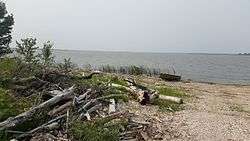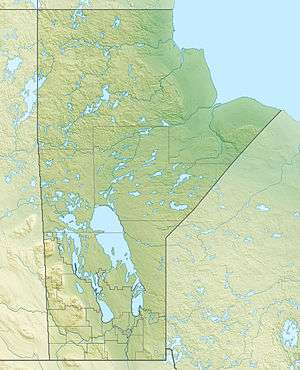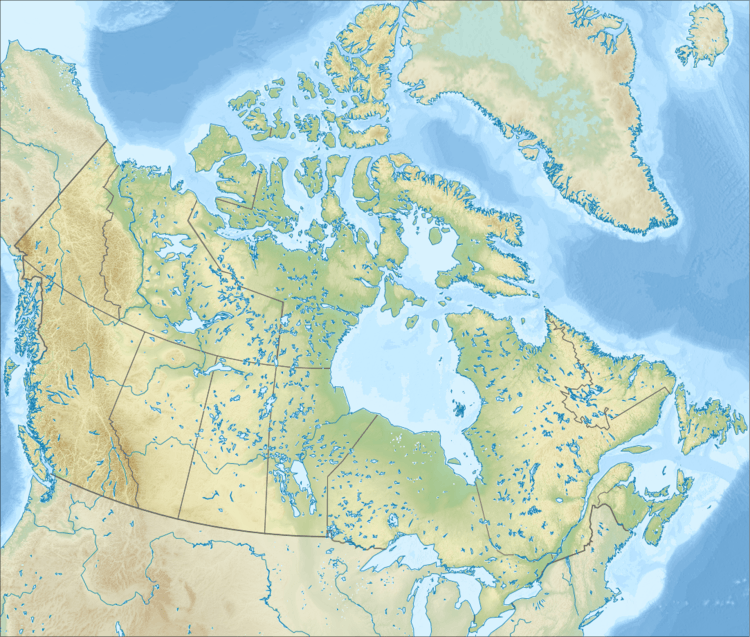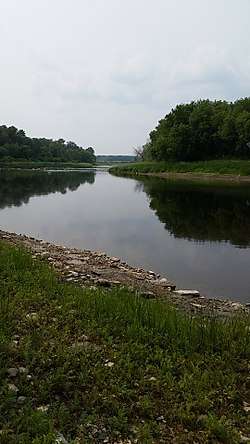Red Deer Lake (Manitoba)
Red Deer Lake is a lake in western Manitoba, Canada. It is located approximately 5 miles (8.0 km) north of Barrows and 10 miles (16 km) west of Dawson Bay which is the northwest part of Lake Winnipegosis, and 8 miles (13 km) east of the Saskatchewan border.
| Red Deer Lake | |
|---|---|
 Photo taken on the south shore of the lake at Red Deer Lake, Manitoba | |
 Red Deer Lake  Red Deer Lake | |
| Location | Western Manitoba |
| Coordinates | 52°57′N 101°22′W |
| Primary inflows | Red Deer River |
| Primary outflows | Red Deer River |
| Basin countries | Canada |
| Surface elevation | 860 ft (260 m) |
In 1901, the Red Deer Lumber Company opened a sawmill on the south shore of the lake, and built a rail spur to connect the mill to the Canadian Northern Railway line to the south.
The company also created two settlements to serve the mill: the community of Red Deer Lake was built near the mill on the lakeshore, and the community of Barrows was built at the railway junction. The sawmill closed in 1926.[1]
The lake is situated almost entirely in the northwest corner of Manitoba's Census Division No. 19, although its northernmost reaches extend into the southwest corner of Division No. 21.
The area is heavily forested, and in the years since the Red Deer Lumber Company's mill closed, the area has hosted a number of other logging companies and smaller sawmills as well.[2] Fishing is common and fisheries in the lake and Dawson Bay process catch from Red Deer Lake. There is also coal exploration in the area as well, targeting the Mannville Formation.[3][4]
Red Deer River
| Red Deer River | |
|---|---|
 A photo of the Red Deer River near Erwood, Saskatchewan | |
| Location | |
| Country | Canada |
| Province | |
| Physical characteristics | |
| Mouth | |
• location | Dawson Bay on Lake Winnipegosis |
| Basin size | 11,000 km2 (4,200 sq mi) |
The Red Deer River arises in east central Saskatchewan and flows east through Red Deer Lake into Dawson Bay of Lake Winnipegosis. To the north of its basin is that of the Saskatchewan River and to the southwest that of the upper Assiniboine River and to the southeast that of the Swan River (Manitoba-Saskatchewan)
Fort Red Deer River
Fort Red Deer River or Fort Rivière la Biche was a North West Company trading post on the Red Deer River near the town of Hudson Bay, Saskatchewan. It was founded in 1794 by Hugh McGillis, and its date of closure is uncertain. Losey places it at the mouth of the Etomami River at the town ballpark where there is a provincial marker (52°49′08″N 102°22′44″W in the Hudson Bay Regional Park).[5]
In 1774, Matthew Cocking described two trading posts on the Red Deer River. The Lower Settlement was located on a flat just upriver of the lake, while the Upper Settlement was located 60 miles upriver of the lake. The Upper Settlement likely became Fort Red Deer River. Ruins from both settlements were found by J.B. Tyrrell in 1889.[1]
Alexander Mackenzie considered this fort to be one of the three chief trading posts of the Lake Manitoba district. The trading post sat at the approximate intersection of the Assiniboine tribes to the south, and the Swampy Cree tribes to the north.[1]
References
- Hudson Bay & District Cultural Society (1982). Valley Echoes: Life Along the Red Deer River Basin. Winnipeg, Manitoba: Inter-Collegiate Press.
- "Historic Sites of Manitoba: Red Deer Lumber Company and Bank Vault (Northern Manitoba)". www.mhs.mb.ca. Retrieved 2019-10-26.
- http://www.infomine.com/index/properties/RED_DEER_LAKE_COAL.html
- Robert Charles Wallace (1919). Mining and mineral prospects in northern Manitoba. p. 38.
- Elizabeth Browne Losey (1999). Let Them be Remembered: The Story of the Fur Trade Forts. p. 211.